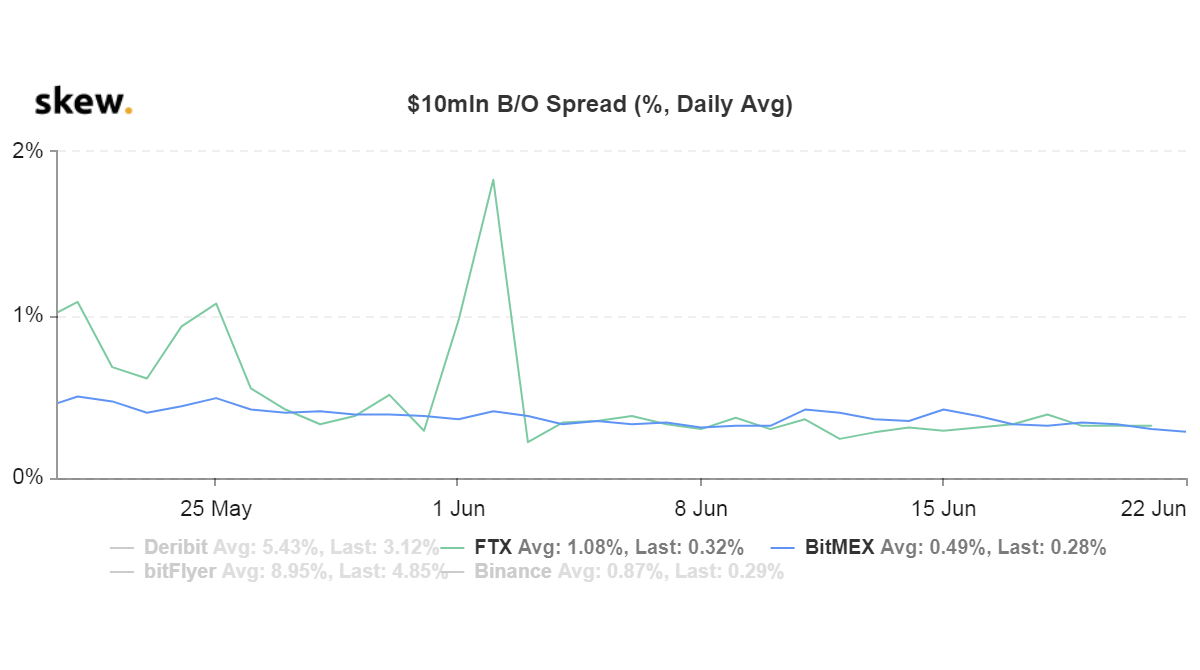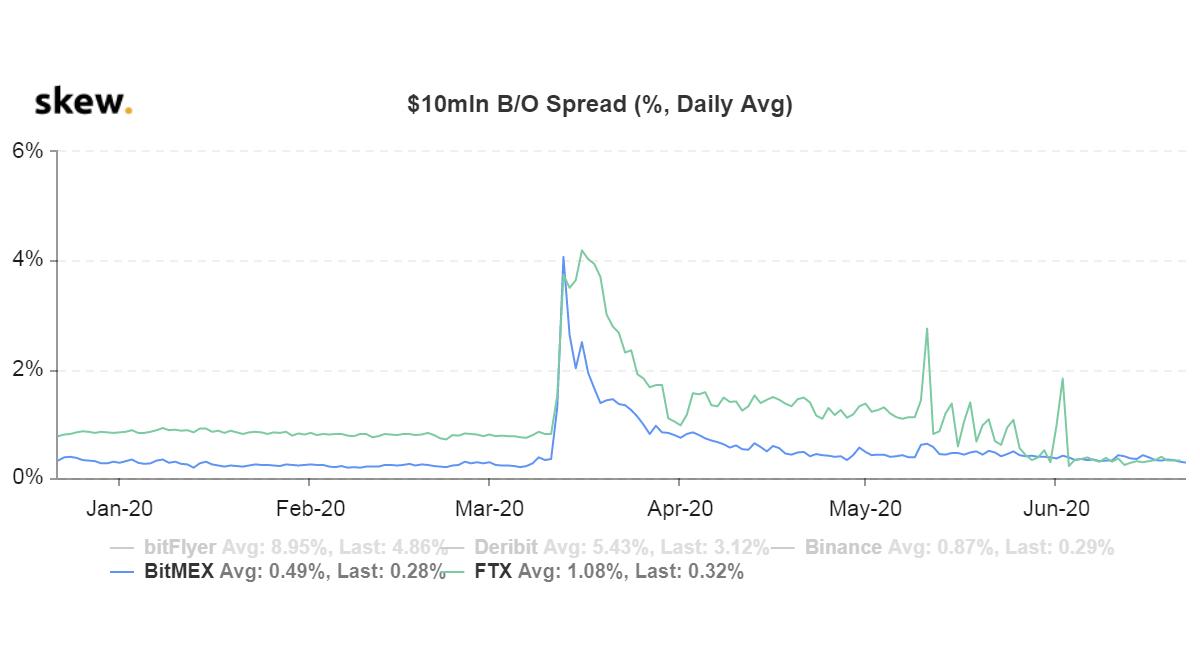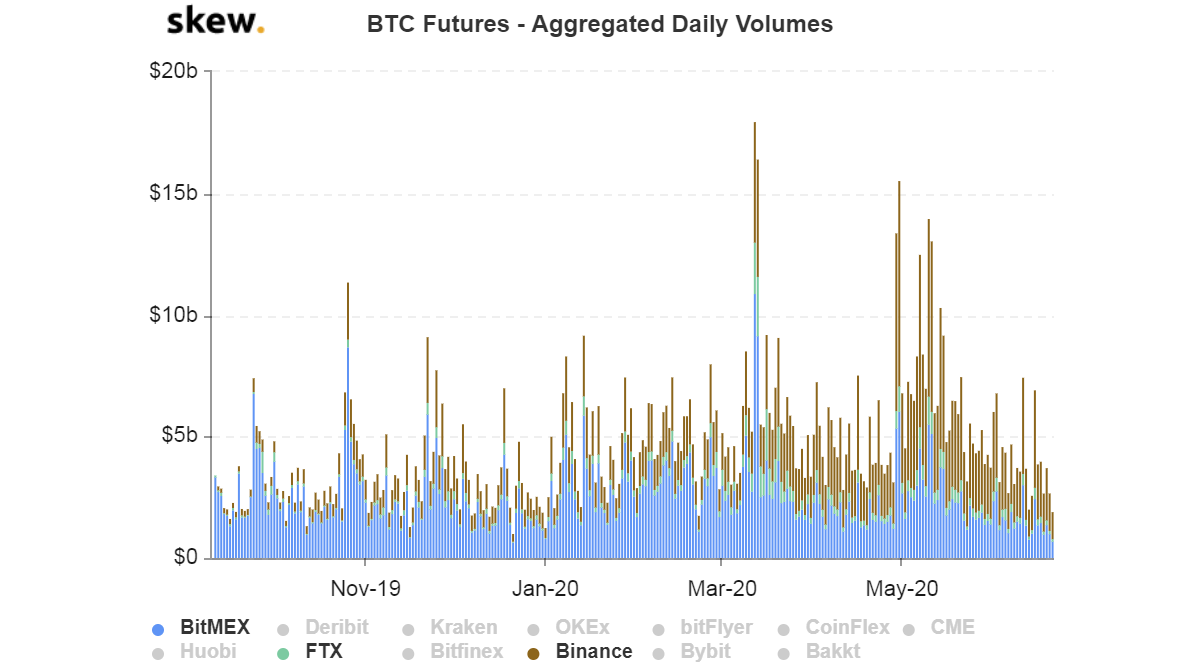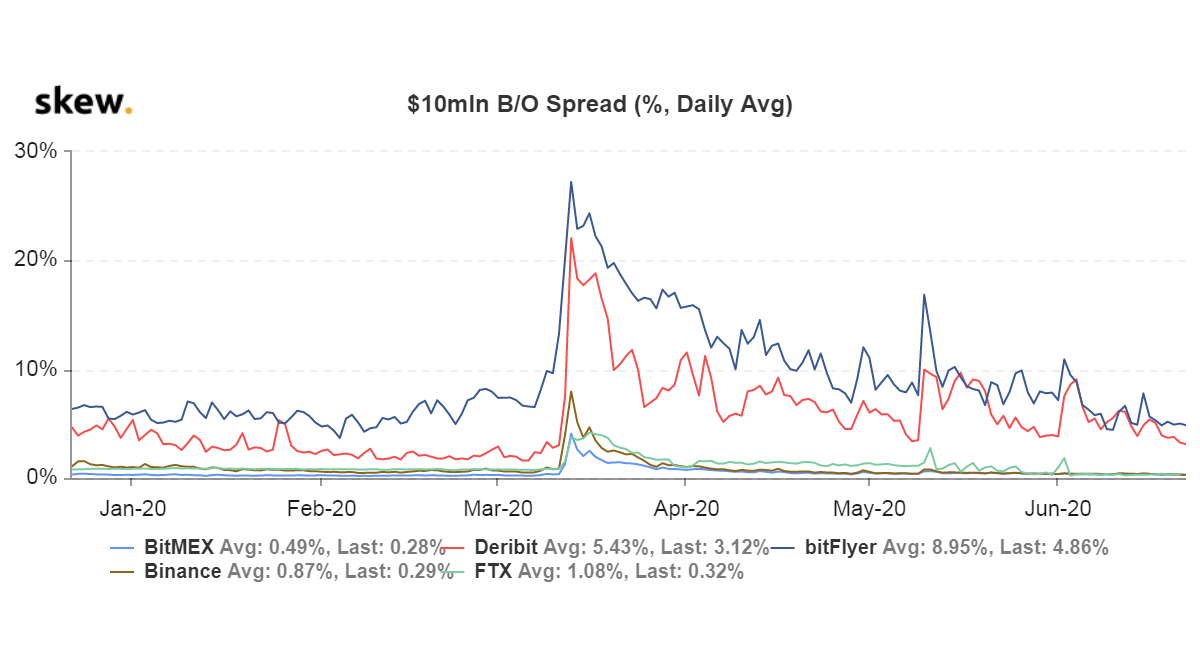For a second month in a row, the bitcoin market lacks a clear directional bias, with prices largely restricted to a narrow range of $9,000 to $10,000. However, the cryptocurrency’s liquidity on derivative exchanges continues to heat up, a sign of a sustained rise in investor interest.
On a relatively new exchange like the Antigua-based FTX, the order book depth, as represented by the number of buy and sell orders at each price, now matches the depth seen on industry leader BitMEX.

Bid/offer spread
One derivative seeing growth is bitcoin perpetuals, a form of futures contract, but without an expiry date and thus without a settlement. Perpetuals have a funding rate that occurs every eight hours and traders holding a position at the funding timestamp receive or pay funding.
As of Monday 13:10 UTC (9:10 a.m. ET), the daily average bid/offer spread for bitcoin perpetual swaps for $10 million quote size on FTX is 0.32% compared to 0.28% on BitMEX, according to data provided by the crypto derivatives research firm Skew. BitMEX was founded in 2014 and is one of the largest bitcoin perpetuals exchanges by trading volumes while FTX launched in May 2018.
The bid–offer spread is the difference between the prices quoted for an immediate sale and an immediate purchase for an asset. The larger the gap, the greater the spread. A small spread implies a highly liquid market and vice versa.
As such, one may conclude FTX is less liquid than BitMEX. While that is true, the liquidity gap between the two has reduced substantially over the past two months. “Liquidity for bitcoin perpetual swaps on FTX has caught up with BitMEX," Skew tweeted Friday.

Bid/offer spread
The bid/offer spread on perpetuals listed on BitMEX and FTX rose sharply after bitcoin collapsed by 40% on March 12. The spread tends to widen dramatically during a price crash when traders offload large quantities of assets within a short period of time.
The market depth was decimated following the March 12 bitcoin price crash of 40%. However, even then, BitMEX was reporting a lower spread than other exchanges.
FTX consistently reported a higher spread before the March crash and for nearly 2.5 months following the price slide. Notably, FTX registered a spread of 2.75% on May 11, when the cryptocurrency underwent its third mining reward halving. On that day, the spread on BitMEX was 0.63%.
The situation, however, changed earlier this month, with the spread on FTX converging with that on BitMEX.
"Over time we've seen increasing volume and a growing user base on FTX as more of the crypto ecosystem onboards," an FTX spokesperson told CoinDesk, adding, "We've particularly put an emphasis on growing the liquidity base over the past six months, and this quarter it's started paying off."

Global volume
Trading volumes on FTX surged from $44 million on Jan. 1 to $2.4 billion on March 13. However, volumes have since tapered off to levels seen in January this quarter, although the decline is not just limited to FTX and is seen across major exchanges.
However, FTX and Binance have suffered more than 80% decline in daily trading volume over the past three months, while BitMEX has seen nearly 40% decline, according to Skew data. That explains why BitMEX is still more liquid than FTX.
Not just FTX
Binance’s order book depth, too, has improved over the past three months. At press time, the daily average bid/offer spread on Binance for a $10 million quote is 0.29% - nearly indistinguishable from the 0.28% seen on BitMEX.

Bid/offer spread
Also, Binance’s spread narrowed to BitMEX levels in April, that is, nearly two months before FTX registered a similar decline.
Meanwhile, derivative exchanges Deribit and bitFlyer are still relatively less liquid, with bid/offer spreads at 3.12% and 4.86%, respectively. One possible explanation for the relatively low liquidity on these platforms could be the fact that they account for negligible amount of global futures/perpetuals volume. Notably, Deribit, which is the largest options exchange by volume, contributed just 1.3% of total volume traded on Sunday, as per data source Skew.
Looking forward, both Deribit and bitFlyer and other exchanges are likely to see higher liquidity because institutional participation is expected to increase over the long run. The coronavirus crisis has established bitcoin as a macro asset, according to Messari analysts. Further, legendary macro traders like Paul Tudor Jones II have recently thrown their weight behind bitcoin as a inflation-hedge asset.
DISCLOSURE
Please note that our privacy policy, terms of use, cookies, and do not sell my personal information has been updated.
The leader in news and information on cryptocurrency, digital assets and the future of money, CoinDesk is a media outlet that strives for the highest journalistic standards and abides by a strict set of editorial policies. CoinDesk is an independent operating subsidiary of Digital Currency Group, which invests in cryptocurrencies and blockchain startups. As part of their compensation, certain CoinDesk employees, including editorial employees, may receive exposure to DCG equity in the form of stock appreciation rights, which vest over a multi-year period. CoinDesk journalists are not allowed to purchase stock outright in DCG.
:format(jpg)/cloudfront-us-east-1.images.arcpublishing.com/coindesk/OPY3KP2KTRGKVLNACPIHGBKMP4.jpg)

:format(jpg)/cloudfront-us-east-1.images.arcpublishing.com/coindesk/PFEHNV7HU5CCPFROJKQIPWNYJU.jpg)
:format(jpg)/cloudfront-us-east-1.images.arcpublishing.com/coindesk/YLVK7NL7PJAVRJVREC7DTR6XME.jpg)
:format(jpg)/cloudfront-us-east-1.images.arcpublishing.com/coindesk/EXPOIBREMFHSHA7CVOGJ5TDWUY.jpg)
:format(jpg)/cloudfront-us-east-1.images.arcpublishing.com/coindesk/PJTR3KRDWJCRVE3QREM6KUOK7A.png)